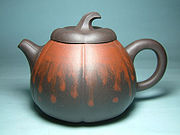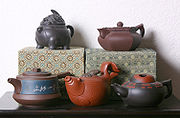
Yixing clay teapot
Encyclopedia

Yixing clay
Yixing clay is a type of clay from the region near the city of Yixing in Jiangsu province, China. Its use dates back to the Song Dynasty when purple clay was first mined around Lake Taihu in China. From the 17th century on, the ware was commonly exported to Europe. The finished stoneware, which...
. This traditional style commonly used to brew tea
Tea
Tea is an aromatic beverage prepared by adding cured leaves of the Camellia sinensis plant to hot water. The term also refers to the plant itself. After water, tea is the most widely consumed beverage in the world...
originated in China
China
Chinese civilization may refer to:* China for more general discussion of the country.* Chinese culture* Greater China, the transnational community of ethnic Chinese.* History of China* Sinosphere, the area historically affected by Chinese culture...
, dating back to the 15th century, and are made from clay produced in the region of the town of Yixing
Yixing
Yixing is a county-level city in Jiangsu province, in eastern China with a population of 1.3 million. It is well-known for its Yixing clay and the pottery -- especially the "zisha"-style teapots -- made from the clay...
in the eastern Chinese province of Jiangsu
Jiangsu
' is a province of the People's Republic of China, located along the east coast of the country. The name comes from jiang, short for the city of Jiangning , and su, for the city of Suzhou. The abbreviation for this province is "苏" , the second character of its name...
.
Origin
Archaeological excavations reveal that as early as the Song DynastySong Dynasty
The Song Dynasty was a ruling dynasty in China between 960 and 1279; it succeeded the Five Dynasties and Ten Kingdoms Period, and was followed by the Yuan Dynasty. It was the first government in world history to issue banknotes or paper money, and the first Chinese government to establish a...
(10th century) potters near Yixing were using local "zhisha" clay to make utensils that could have functioned as teapots. The late Ming Dynasty
Ming Dynasty
The Ming Dynasty, also Empire of the Great Ming, was the ruling dynasty of China from 1368 to 1644, following the collapse of the Mongol-led Yuan Dynasty. The Ming, "one of the greatest eras of orderly government and social stability in human history", was the last dynasty in China ruled by ethnic...
author Zhou Gaoqi stated that during the reign of the Zhengde Emperor
Zhengde Emperor
The Zhengde Emperor was emperor of China between 1505-1521. Born Zhu Houzhao, he was the Hongzhi Emperor's eldest son...
(1502–1521) a monk from Jinsha Temple (Golden Sand Temple) in Yixing handcrafted a fine quality teapot from local clay. Such fine quality teapots soon became popular with the scholarly class, and the fame of Yixing teapots began to spread.
20th century
Yíxīng teapots are not actually made in the regional city of Yíxīng, but rather in nearby Dīngshān, also known as Dingshu, which falls within the administrative area of Yixing. Hundreds of teapot shops line the edges of the town's crowded streets and it is a popular tourist destination for many Chinese. While Dīngshān is home to dozens of ceramics factories, Yíxīng Zǐshā Factory Number 1, which opened in 1958, processes a large part of the clay used in the region, produces fine pottery ware, and has a large commercial showroom. In addition to the better known teapots, frescoes, oil and grain jars, flower vases, figurines, glazed tiling, tables, ornamental rocks, and even ornamental waste bins are all manufactured in the community.Price
Prices can vary from a couple dozen yuan to thousands of yuan per teapot. In 2010 a pot was auctioned for 12.32 million yuan. Some Chinese National treasures have even been deemed priceless. Generally, the price of Yixing teapots are dependent on such factors such as age, clay, artist, style and production methods. The more expensive pots are shaped by hand using wooden and bamboo tools to manipulate the clay into form, while cheaper Yixing pots are produced by slipcastingSlipcasting
Slipcasting is a technique for the mass-production of pottery, especially for shapes not easily made on a wheel. A liquid clay body slip is poured into plaster moulds and allowed to form a layer, the cast, on the inside cavity of the mould...
.
Characteristics and use with tea

Black tea
Black tea is a variety of tea that is more oxidized than the oolong, green, and white varieties.All four varieties are made from leaves of the shrub Camellia sinensis. Black tea is generally stronger in flavor and contains more caffeine than the less oxidized teas. Two principal varieties of the...
and oolong teas, as well as aged pǔ’ěr
Pu-erh tea
Pu'er, Pu-erh, Puer, also Po Lei or Bolay is a variety of post-fermented tea produced in Yunnan province, China. Post-fermentation is a tea production style in which the tea leaves undergo a microbial fermentation process after they are dried and rolled. This is a Chinese specialty and is sometimes...
tea. They can also be used for green
Green tea
Green tea is made solely from the leaves of Camellia sinensis that have undergone minimal oxidation during processing. Green tea originates from China and has become associated with many cultures throughout Asia. It has recently become more widespread in the West, where black tea is traditionally...
or white tea
White tea
White tea is a lightly oxidized tea grown and harvested almost exclusively in China, primarily in the Fujian province.White tea comes from the delicate buds and younger leaves of the Chinese Camellia sinensis plant. These buds and leaves are allowed to wither in natural sunlight before they are...
, but the water must be allowed to cool to around 85 degrees Celsius before pouring the water into the pot. Yixing teapots absorb a tiny amount of tea into the pot during brewing. After prolonged use, the pot will develop a coating that retains the flavor and color of the tea. It is for this reason that soap should not be used to clean Yixing teapots. Instead, it should be rinsed with fresh water and allowed to air-dry. A studious tea connoisseur will only steep one type of tea in a particular pot, so as not to corrupt the flavor that has been absorbed.
Traditionally, some Chinese would pour the tea from the spout directly into their mouths.
Yixing teapots are smaller than their western counterparts as the tea is often brewed for only a few seconds before it is served to guests. Reusing the same tea leaves multiple times, the first brew of the tea leaf is usually used only to clean tea, teapot, and cups and is not to be consumed. Chinese people traditionally drink from cups that hold less than one ounce of liquid and are simply repeatedly filled so that they may cool rapidly but can be ingested before the tea becomes cold.
Yixing teacups meant for steeping tea directly in the cup are also available.
Further reading
- K.S. Lo, et al., The Stonewares of Yixing: from the Ming period to the Present Day, (London, 1986).
- Wain, Peter, "A Taste of Transition: The Teapots of Yixing", Ceramic Review, 153, May/June 1995, pp. 42–45p
- Pan Chunfang, Yixing Pottery: the World of Chinese Tea Culture, (San Francisco: Long River Press, 2004).
External links
- Yixing Clay Teapot at China Online Museum

